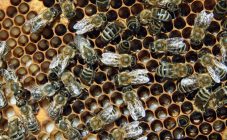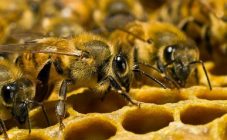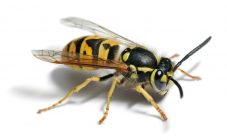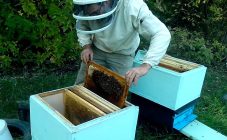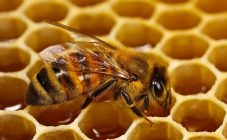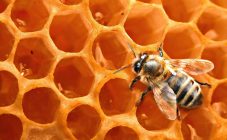Content:
Having seen a strange insect in your own garden, especially not in a single copy, it is better to learn more about it in order to be sure of its harmlessness or danger to people. Recently, these include the carpenter bee, which is also known as the blue bee.
Common carpenter bee
The insect belongs to the Apidae family and a species of single bees. This particular species has a relatively large size - the body length reaches a maximum of 3 cm. In the common people, a carpenter bee is called a xylocop or tree nest. In total, there are more than 500 species that unite 30 breeds. Outwardly, most of them differ only in shades.
Individuals living in Russia are more like shaggy flies with a black body and beautiful wings that shine with a blue-violet or blue sheen.
Description of lifestyle and habitat
The wood bee gets its name from the fact that it makes a dwelling combs in dead wood, cutting through multi-level nests with numerous cells, in each of which a larva will develop.
During the "construction work" it makes sounds like a modern drill. Sounds can be heard within a radius of several meters. The entrance to the monastery is always perfectly round and alone, as if it had been drilled with a drill.
Since the nest is created rather for the future generation, the children of the bee can also use it, but this is not necessary. As a rule, only a couple of individuals remain, or even one when the queen dies. Building housing is one of their basic instincts.
There are carpenter bees all over the Earth, but most of them settled in the central and western parts of Europe, in the Caucasus. In Russia, single insects are found in the Stavropol and Krasnodar Territories, the Central Black Earth Region, the Volga Region and other places where the climatic conditions are similar.
Due to the fact that the most favorite nesting place of the blue bee is dead wood, it is most often found in summer cottages, next to parks, forests and groves. Fences, old telegraph poles, and other structures made of this material are ideal shelters for her.
When choosing a place, the location of the food source plays an important role, but carpenter bees can fly many kilometers in search of food.
The diet is no different from that of ordinary bees: pollen from plants, sweet fruits, etc. Collecting pollen, she smears it with her saliva and dilutes it with nectar stored in honey crop. Thanks to this, during a long flight, the collected material does not fall apart.
The bee saliva contains special microbes that instantly start the fermentation process and turn the product into bee bread. It feeds on adults and only larvae that have appeared. But for the latter, the bees convert the substance into protein-rich royal jelly.
Do they pose a danger to humans
An ordinary carpenter bee stings quite painfully, moreover, the toxin that has got into the blood is dangerous. The poison injected into the wound immediately provokes a large swelling, which hurts for a long time.The active substance has a depressing effect on the central nervous system and often a nervous shock. If she stings in the throat, it is deadly.
When planning to start getting rid of these insects, you should know several important facts about them:
- Stinging is definitely dangerous, but only females sting. Males do not have the necessary organ for this. Representatives of this species mostly hide in the nest and do not go outside, therefore the chance of being stung is minimal. If this happens, you should immediately consult a doctor.
- Wood bees, or carpenter wasps, as many of them are also called, are very dangerous for wooden buildings, because they violate the integrity of the structure of the array, gnawing whole mines inside. For several years, a structure with at least two nests can collapse.
- Woodpeckers love to eat them. Therefore, seeing a busy bird, you need to scare away. The smell of carpenter bee larvae attracts them from several kilometers away. In an attempt to get a delicacy, the birds gouge even larger holes.
- Blue-blue bees have good reproductive function. One sexually mature female reproduces up to 6 larvae in 1 warm period.
How to get rid of wood bees in the wall of a wooden house with a gentle method
Few disinfection services will contact black bees as it is illegal. Therefore, the question of how to get rid of wood bees on your own is of particular relevance. Given the circumstances, the only way to get rid of insects is with sound vibrations.
The woodcutter bee is very sensitive to noise. It is enough to turn on loud music next to the proposed housing. Preferably a composition with low frequencies - high-quality bass. Blue bees will leave their wooden house on their own.
There is a more aggressive but effective method.
Anti-blue-blue bee remedy
How to deal with wood bees if the noise did not help?
The easiest way to keep these insects out of your home is with sticky flying insect traps. But it is effective for single trapping.
In addition, there are other means:
- If pests are very annoying and pose a real danger to the health of households, one generation can be sacrificed to ensure that they are not in old holes forever. To do this, fill the entire socket through the main passage with an aerosol carburetor cleaner or banal gasoline. At the same time, it is worth remembering the safety measures with such toxic substances, especially when it comes to working with wood.
- Specialty pesticides, especially powder pesticides, are effective enough to destroy homes. Boric acid or carbaryl is most commonly used.
Preventive measures
Having got rid of the carpenter wasps once, no one can guarantee that they will no longer appear in the house or the building where they lived before.
To do this, you need to perform certain manipulations:
- After ruining the nest, you need to clog everything with mineral wool, steel wool or polyurethane foam. All these materials are classified as sealing, and insects will not be able to return to the monastery, and the rest will definitely die.
- Experienced gardeners claim that tree wasps do not settle on buildings treated with paints and varnishes. Therefore, it is the most reliable way to prevent the formation of nests, and hence the accumulation of bees.
- You can also use citrus spray on wooden structures to prevent pests from returning. The tool can be purchased at a special store or made by hand.Most of the bees die from it, and the survivors leave danger in the territory in the genetic code, and their descendants will not settle in the same place.
Method of preparation: you need to chop the peels of orange, lemon, lime, grapefruit and boil for some time in a shallow container, pouring water. After cooling, strain and place in an aerosol spray bottle. It is worth spraying the entrances to the bee abode.
In addition to all of the above, you need to consider the following:
- To stop reproduction, you will have to use only powdered pesticides, since liquid pesticides are absorbed by the wood and do not give the desired effect. Having fallen asleep, in no case should the entrance be sealed, otherwise the pests will begin to grind new ones and will be able to avoid the action of the poison. This can only be done if there is absolute certainty that the adults have left the home.
- If bees have just appeared on the site and have not yet managed to create a large nest, they can be caught with the usual bait for flying insects that like sweet aromas.
Before baiting, you should make sure that you have all the necessary protective clothing, because the females will protect the larvae at the cost of their lives.
If all attempts are unsuccessful, you should look for a team of specialists. In the case of an obvious danger to human life, when there are several nests and many insects, they can only be dealt with by complex treatment. But at the same time, the structure of the structure will also suffer, because you will have to pick out the combs with the larvae.




